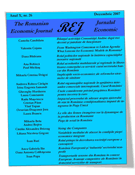Abstract:
This paper employs symmetric GARCH models to investigate the volatility on the Romanian and American stock markets. We consider two empiric time series from each market, consisting in daily logarithmic returns. For Bucharest Stock Exchange, we include the composite index BET-C and TLV(Transilvania Bank), a company listed on BSE and for New York Stock Exchange we consider the S&P 500 index and also the KO stock (Coca-Cola). All time series cover the period January, 03 2001 – February 09, 2008 or a total of 1853 daily returns in each case. For each of the four time series we estimate the simple GARCH(1, 1) model and also the GARCH-in-Mean (1, 1) model. The preliminary investigations show that the time series of TLV does not present the phenomenon of volatility clustering, which is later confirmed by the estimation of the GARCH models. For the other three series, the coefficients of the estimated GARCH models are statistically significant and their sum is close to one for S&P 500 and KO, which implies persistence of the conditional variance for the two processes. For BET-C, the process reverts to the mean more rapidly. The diagnostics confirm that the symmetric models are correctly specified for S&P 500 and KO, while in the case of BET-C the estimated models did not remove all heteroskedasticity from the residuals, suggesting that we must find other specifications for the variance equation. In addition, The GARCH-in-Mean model confirms that increased risk will lead to a rise in future returns for all considered series, the coefficient of the conditional standard deviation being positive and statistical significant in all cases.
